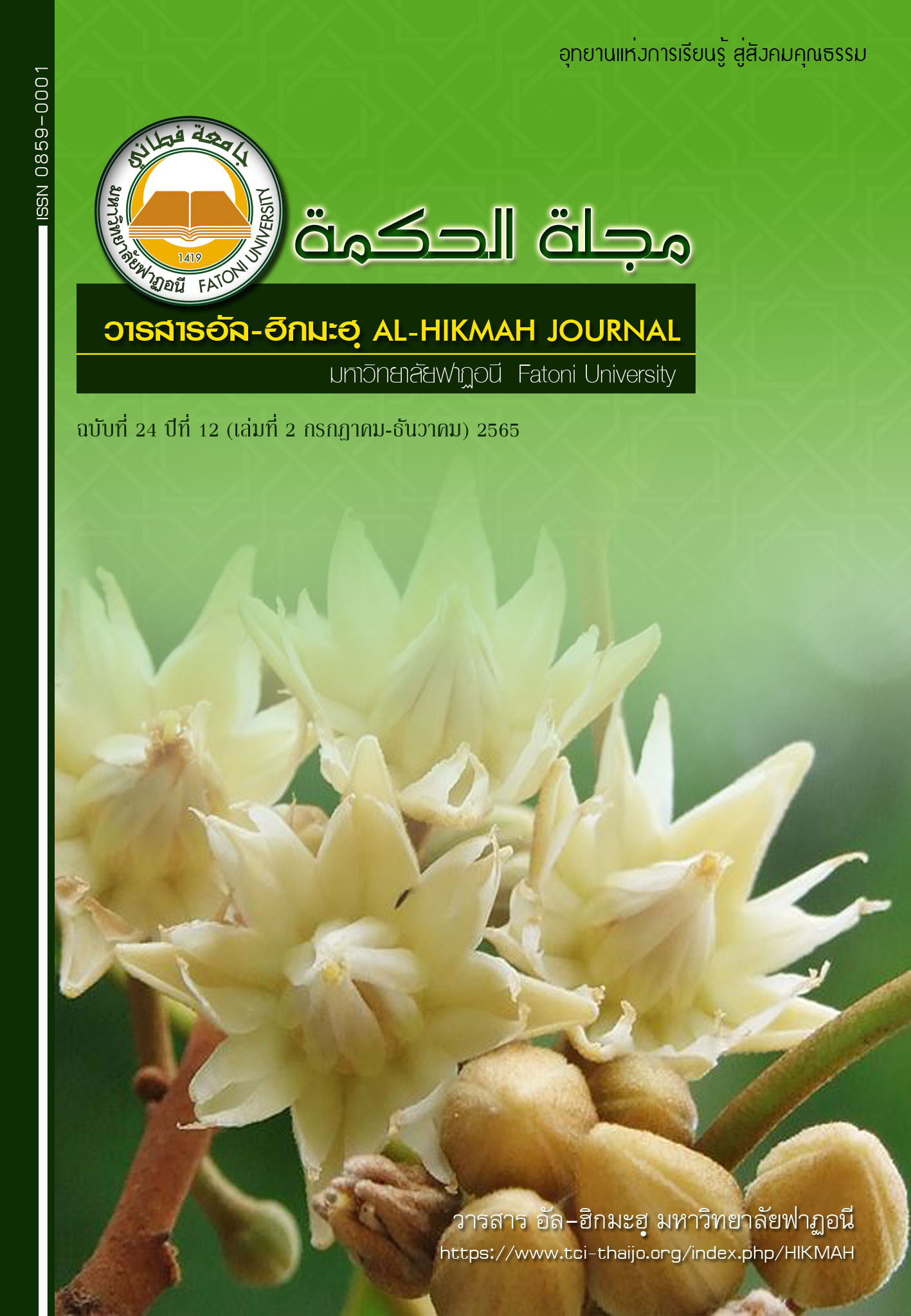ทัศนคติของนักศึกษาในบริบทที่ใช้ภาษาอังกฤษเป็นภาษาต่างประเทศที่มีต่อการเรียนภาษาอังกฤษโดยการใช้กลยุทธ์ภาษาเป้าหมาย
บทคัดย่อ
วัตถุประสงค์ของงานวิจัยนี้คือเพื่อสำรวจความคิดเห็นของผู้เรียนที่มีต่อการเรียนภาษาอังกฤษโดยการใช้ กลยุทธ์ภาษาเป้าหมายกลุ่มตัวอย่างที่ใช้ในงานวิจัยนี้ ได้แก่ นักศึกษา จำนวน 20 คนจากมหาวิทยาลัยแห่งหนึ่งในจังหวัดยะลา เครื่องมือวิจัยที่ใช้ ได้แก่ แบบแบบสอบถาม และสัมภาษณ์แบบกึ่งโครงสร้าง ข้อมูลวิจัยที่ได้วิเคราะห์ข้อมูลเชิงปริมาณ และคุณภาพ และอธิบายในรูปแบบบรรยาย ผลของการวิเคราะห์ข้อมูล พบว่าผู้เรียนมีทัศนคติที่ดีต่อการเรียนภาษาอังกฤษโดยการใช้กลยุทธ์ภาษาเป้าหมาย (x̄ =3.77) เมื่อพิจารณาถึงทัศนะคติแต่ละด้านพบว่า ด้านที่ผู้เรียนมีทัศนะคติที่ดีที่สุดคือ สื่อการสอน (x̄ =4.19) ด้านที่ผู้เรียนมีทัศนะคติที่น้อยที่สุดคือ ด้านกระบวนการสอน (x̄ =3.28) ผลของแบบสอบถามแบบกึ่งโครงสร้าง และแบบสัมภาษณ์ พบว่า ผู้เรียนมีทัศนะคติต่อการเรียนภาษาอังกฤษโดยการใช้กลยุทธ์ภาษาเป้าหมายที่แตกต่างกัน ผู้เรียนเห็นด้วยว่ากลยุทธ์นี้ ไม่ได้แค่ช่วยให้ผู้เรียนพัฒนาทักษะภาษาอังกฤษเท่านั้น แต่ยังรวมถึงทักษะความรับผิดชอบต่อตนเอง เนื่องจากช่วยให้ผู้เรียนพึ่งตนเองมากขึ้น อย่างไรก็ตาม พบทัศนะคติในด้านลบเช่นกัน ผู้เรียนเห็นว่ากลยุทธ์การสอนนี้ไม่เหมาะสำหรับผู้เรียนที่มีทักษะภาษาอังกฤษอ่อน ผลของวิจัยเล่มนี้สรุปได้ว่าการเรียนรู้โดยการใช้กลยุทธ์ภาษาเป้าหมาย สามารถนำมาใช้ในการสอนเพื่อพัฒนาทักษะภาษาอังกฤษ ในระดับอุดมศึกษา และบริบทที่ใช้ภาษาอังกฤษเป็นภาษาที่สองได้ โดยพิจารณาปัจจัยที่เกี่ยวข้องอย่างรอบคอบ
เอกสารอ้างอิง
Arulselvi, E. (2011). Effect of instructional media in the learning of English grammar on the achievement of teacher training students at
Namakkal, district. Journal on English Language, 1(3), 80-87.
Bateman, B. E. (2007). Student Teachers’ Attitudes and Beliefs About Using the Target Language in the Classroom. Foreign Language
Annals, 41(1), 11-28.
Dearden, J. (2014). English as a medium of instruction–a growing global phenomenon. British Council. Retrieved on 23 February 2021
from http://www.British council. org/education/ihe/knowledgecentre/english-language-higher-education/reportenglish-medium-
instruction
Dickson, P. (1996). Using the target language: a view from the classroom. Slough: NFER.
Harmer, J. (1984). The Practice of English Language Teaching. London: Longman.
Horasan, S. (2014). Code-switching in EFL classrooms and the perceptions of the students and teachers. Journal of Language and
Linguistic Studies, 10, 31–45.
Ima, N. (2017). Thesis of Developing Instructional Media of Basic English Grammar Weblog for the First Year Students of Senior High
School 11 Makassar.
Jack, C. R., & Ricard S. (2002). Longman Dictionary of Language Teaching and Applied Linguistics, (Third Edition). London: Longman.
Krashen, S. (1982) Newmark's "Ignorance Hypothesis" and current second language acquisition theory. Unpublished manuscript.
Levine, G. S. (2003). Student and instructor beliefs and attitudes about target language use, first language use, and anxiety: Report of a
questionnaire study. Modern Language Journal, 87, 343–364.
Long, M., (1981). Input, interaction and second language acquisition. In Winitz, H. (Ed.), Native language and foreign acquisition (sic).
Annals of the New York Academy of Sciences, 379, 259– 278.
Pan, Y. (2010). The Use of L1 in the Foreign Language Classroom. Colombian Applied Linguistics, 12(2), 87-96.
Polio, C. G., & Duff, P. A. (1994). Teachers' language use in university foreign language classrooms: A qualitative analysis of English and
target language alternation. The Modern Language Journal, 78(3), 313-326.
Punthumasen, P. (2007). International Program for Teacher Education: An Approach to Tackling Problems of English Education in Thailand. The 11th UNESCO-APEID international conference. Retrieved from http://www.worldreform.com/pub/paperies13dec07.pdf.
Ratanapinyowong, P. Poopon, K. & Honsa, Jr.S. (2007). Problems and solutions in teaching and assessing English skills in Thai higher
education and the need for professional development. Voices of Asia 2007 Symposium, MARA University of Technology (UiTM),
Malaysia.
Sojisirikul, P. (2009). Problem-based learning and task-based learning approaches for English writing courses (Doctoral dissertation, Suranaree University of Technology). Retrieved from http://sutir.sut.ac.th:8080/sutir/bitstream/123456789/3729/2/Fulltext .pdf.
Swain, M. (1995). Three functions of output in second language learning. In Cook, G. & Seidlhofer, B. (Eds.), Principle and practice in
applied linguistics: Studies in honour of H. G. Widdowson. Oxford, England: Oxford University Press.
Turnbull, M., & Arnett, K. (2002). Teachers’ uses of the target and first languages in second and foreign language classrooms. Annual
review of applied linguistics, 22, 204-218.
Vygotsky, L. (1986). Thought and Language. Cambridge, MS: The Massachusetts Institute of Technology.
Walsh, S. (2002). Construction or Obstruction: Teacher Talk and Learner Involvement in the EFL Classroom. Language Teaching Research,
(1), 3-23.
Wiriyachitra, A. (2002). English language teaching and learning in Thailand in this decade. Thai TESOL Focus, 15(1), 4-9.
ดาวน์โหลด
เผยแพร่แล้ว
รูปแบบการอ้างอิง
ฉบับ
ประเภทบทความ
สัญญาอนุญาต
ลิขสิทธิ์ (c) 2022 วารสาร อัล-ฮิกมะฮฺ มหาวิทยาลัยฟาฏอนี

อนุญาตภายใต้เงื่อนไข Creative Commons Attribution-NonCommercial-NoDerivatives 4.0 International License.



